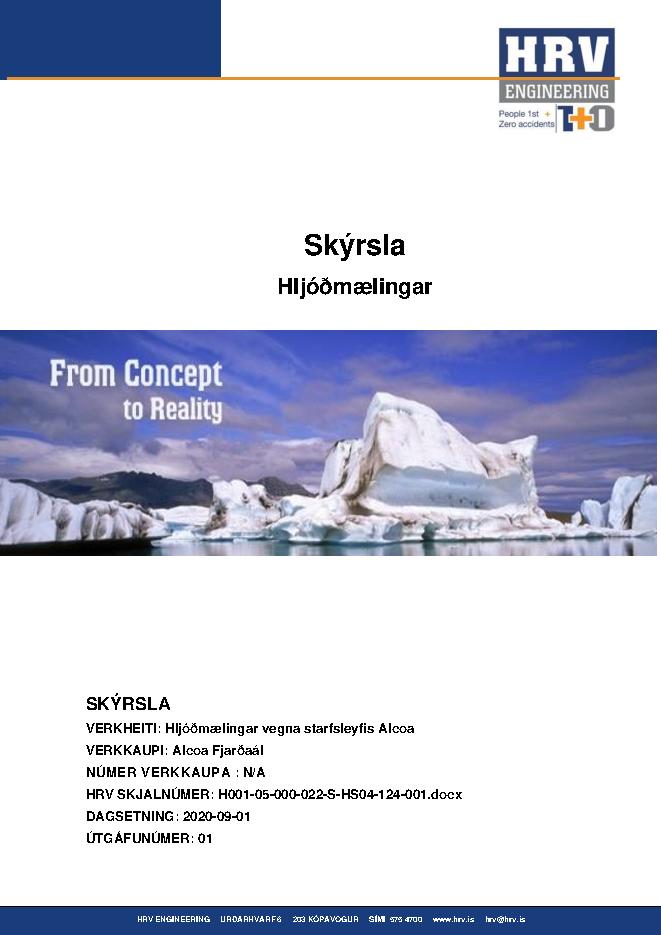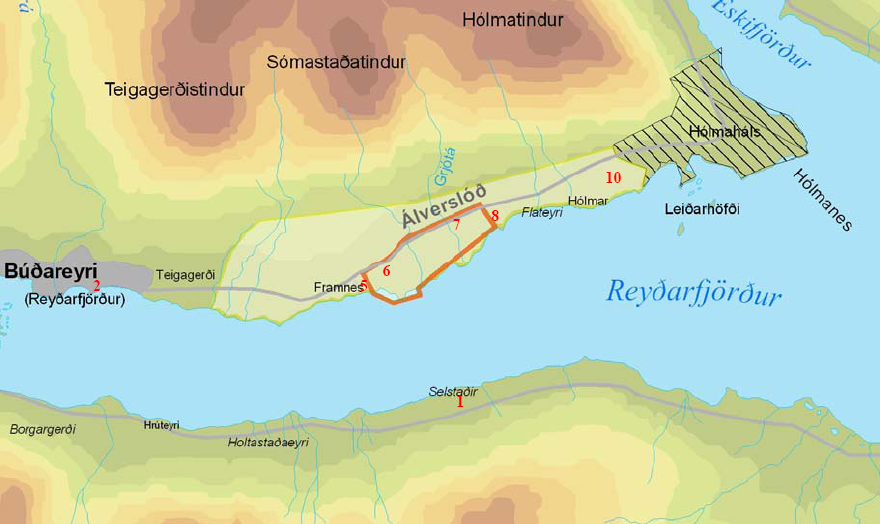Progress
To monitor whether noise from the smelter is within the set limits, sound levels close to the smelter were measured in August 2008, 2012, and 2020. The main sources of noise are the unloading equipment at the harbor and the Fume Treatment Plant (FTP). The noise was measured while the unloading equipment was on. Noise levels were measured in 7 places in Reyðarfjördur: 4 places by the border of the smelter site, by the farm of Hólmar, in the town of Reyðarfjördur, and south of the fjord facing the smelter site (Figure 4). The maximum level set for the site border is 70 dB(A), and all results were below that limit.
The results of the measurements can be seen in Figures 1 - 3. The average volume was measured.
Figure 3. Average noise level at 7 monitoring stations during the night in the vicinity of the smelter and in Reyðarfjörður dB(A).
Updated: June 4, 2021
Source: Alcoa Fjarðaál
Metrics, Targets and Monitoring Protocol
What is measured?
- Average Noise Level dB(A) at established monitoring stations at the smelter site. (Project effect: direct).
Monitoring Protocol
- Continuous noise monitor will record data for specified intervals. Data is collected monthly to decide the baseline and thereafter each time the noise level is expected to change.
Targets
- Day/Evening/Night Noise Levels (db(A)):
- Smelter: 70/70/70
- Light Industry/Dwellings: 55/50/40
- Dwellings Only: 50/45/40
- Summer House: 40/35/35
- Noise level in Reyðarfjörður
- Construction: Less than or equal to 65 db(A)
- Operation: Less than or equal to 55 db(A)
Possible countermeasures
Alcoa has a direct impact with its operations. Response plans aim to maintain volume in line with set goals.
Changes of indicator
This indicator was originally number 16.1. It was then named Noise in Reyðarfjörður and can be found under that number in documents of the project from 2005 and 2006.
The indicator number has been changed twice.
| Year | Nr. | Indicator name |
|---|---|---|
| 2020 | 4.4.2 | Noise pollution in Reyðarfjörður |
| 2007 | 2.11 | Noise Pollution at Fjarðaál and in Reyðarfjörður |
Baseline
Base noise levels in the village of Reydarfjordur are approximately 40-50 decibels. Construction work has recently started on the smelter. Construction-related noise level is expected to be within the limits defined in Iceland regulation (no. 933/1999) concerning allowable maximum noise levels for residential housing areas in Iceland (smelter EIA, 2002).
Rationale for Indicator Selection
Ambient noise levels influence the quality of life in a community. The presence of consistent, loud noise detracts from the appeal of an area and may be detrimental to the long-term sustainability of the community. Local community residents are concerned that the Fjardaal smelter near Reydarfjordur could have a negative effect on noise levels in the village. Noise levels will be driven primarily by the transportation of materials, equipment, and personnel to the plant, as well as plant operations.
From phase I/II report on indicators and baseline from April 2005
Further reading

Hljóðmælingar vegna starfsleyfis
Að beiðni Alcoa Fjarðaráls voru framkvæmdar hljóðmælingar fyrir utan lóð álversins. Samsvarandi mælingar voru áður framkvæmdar af HRV árið 2012, VST-Rafteikningu árið
2008 og Cowl árin 2006, 2005 og 2004. Allar þessar mælingar eru hluti af eftirliti vegna starfsleyfis álversins.
Mæliniðurstöðurnar sýna að viðmiðunarmörk starfsleyfisins um 70 dB(A) jafngildishljóðstig, fyrir öll tímabil sólarhringsins eru uppfyllt. Í starfsleyfi stendur: „Hávaði við húsvegg utan vinnusvæðis rekstraraðila skal ekki fara yfir 70 dB(A) á iðnaðarsvæði og 55 dB(A) í íbúðabyggð“
You can view more material related to the indicator by clicking on the link above.

